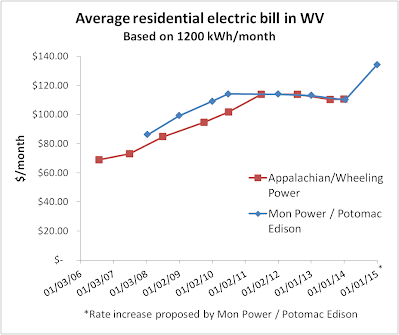Why the rate hikes?
High electricity bills have become a serious issue for West Virginians. The average customer of Appalachian Power and Wheeling Power (both subsidiaries of American Electric Power) has seen their bill go up nearly 60% from 2007 to 2011. Similarly, the average customer of Monongahela Power and Potomac Edison (both subsidiaries of Allegheny Energy, now FirstEnergy) saw their bill go up over 30% since 2008.
What is going on?
control equipment. Base rate cases are where rates are set so that the company can recover all of its other costs, including any investment in new generation, maintenance costs, administrative costs (including executive bonuses ...), etc. Both the ENEC and base rates are rolled into the final rate that customers actually pay. Of the $620 million in increased revenues that have been approved for Appalachian & Wheeling Power Companies since 2006, less than 10% of that increase has been in base rates. In other words, coal costs purchased power costs, and scrubber costs make up the bulk of the increase in rates.
Electric utilities in West Virginia are regulated by the Public Service Commission, and the utilities must get approval from the Commission before increasing their rates. The Public Service Commission is supposed to set rates so that utilities are able to cover their costs of operation and earn a reasonable return on their investments. When utilities' operating costs change, they file a rate case with the Public Service Commission asking for an increase (or, in theory, a decrease) in rates to cover new costs. There are two types of rate cases before the commission that differ primarily in the types of costs that they cover: "ENEC" cases and base rate cases. "ENEC" cases are where the utilities get Commission approval to recover increases in their fuel costs, purchased power costs, and certain construction costs - including pollution
Most of the rate increases in West Virginia have been due to increasing coal prices and coal price volatility. Consider these facts:
- The cost of coal delivered to the electric power sector in WV increased 70% from 2000 to 2009.
- Much of the recent rate increases can be attributed to what the PSC described as an “extraordinary” spike in coal prices in 2008. This spike was the result of growing international demand for coal, combined with temporary shortages from major producers like China and Australia. Because of the spike in coal prices, some of Appalachian Power's suppliers – including Massey Energy – allegedly failed to fulfill their long-term coal delivery contracts because they could get higher prices for their coal elsewhere. This spike was the main reason why, in 2009, Appalachian Power asked the Public Service Commission for a 43% rate increase and Mon Power and Potomac Edison requested a 20% rate increase.
- The recession has also contributed to increased rates, particularly for Mon Power and Potomac Edison. The recession drove down power demand and electricity prices on the regional electric grid. With lower power prices, Mon Power's old coal plants were unable to compete as well and so it was not economic for Mon Power to run them as often to sell power to the grid. This meant that the utility's expected revenue from generating power declined.
- Less than 20% of Appalachian Power's rate increases can be attributed to the cost of installing pollution control equipment. Almost none of Mon Power and Potomac Edison's recent rate increases are due to pollution control equipment; the last major project, scrubbers at the Fort Martin Power Plant were incorporated into rates in 2007.
- Because so much of West Virginia's electricity is from coal, coal prices and electricity rates track each other closely.
The dominance of coal in our electricity supply puts us at the mercy of future unexpected events that lead to volatility in coal prices. But the trend of rising coal prices indicates that the days of cheap electricity in West Virginia are over.

Residential electric bills went up dramatically from 2007-2011 and
bills have remained high ever since.

